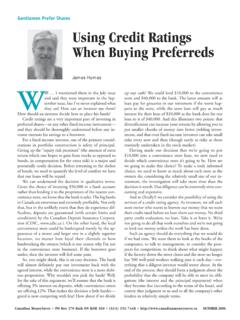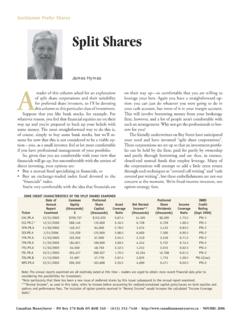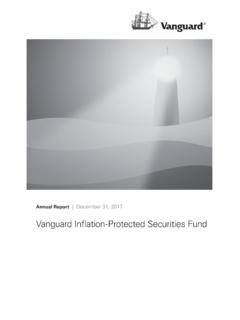Transcription of BAs or BDNs - himivest.com
1 Here s a skill-testing question for advisors: In the event that a ma-jor canadian bank gets wiped out overnight, which of their money market products is safer, a bank-ers acceptance (BA) or a bearer deposit note (BDN)?BAs have a relatively short his-tory in Canada, which has been admirably traced by George Now-lan, and before that by Daryl Mer-rett in the Bank of Canada Review of October 1981. the evolving marketCanadian money markets were un-developed until the 1950s. Short-term bonds were heavily traded, but canadian dollar Treasury Bills (introduced in 1934) were typical-ly a buy-and-hold investment for banks. As the federal government s fiscal agent and conductor of mon-etary policy, the Bank of Canada (BoC) tweaked its own rules in the 1950s and 1960s while encourag-ing changes in federal law to in-crease the trading of treasury bills and the issue of commercial pa-per.
2 This followed similar efforts by the Federal Reserve in the , from the moment of its founding in logical first step in the cre-ation of a commercial paper mar-ket is the establishment of a vi-brant market in BAs a BA being simply short-term paper issued by a corporation, but having a timely repayment of principal guaran-teed ( accepted ) by a bank in exchange for a fee (the stamping fee ). It should be noted that a holder of a BA has no claim on the underlying loan; the BAs are not a credit-enhanced product like covered were launched in Canada on June 11, 1962, and were limit-ed to self-liquidating transactions as defined in the Bank Act of the time. The emphasis on self-liqui-dation may be taken as an empha-sis on safety of principal, since the borrower will not have to refi-nance the loan it will be repaid with the proceeds of the business endeavour it is history of finance is re-plete with examples of short-term loans defaulting because they could neither be refinanced nor covered by sale of the asset it was used to purchase.
3 Readers will doubtless be able to supply examples from the headlines of the past year!Another justification for an in-sistence on self-liquidating trans-actions is the Real Bills Doctrine. Thomas Humphrey summarizes that it holds that money can never be excessive when issued against short-term commercial bills arising from real transactions in goods and services. Central bank theorists now consider this assertion to have been convinc-ingly refuted by Henry Thornton in 1802 but it remained influen-tial with many central banks, in-cluding the Federal Reserve and Deutsche market flourishesIn 1978, this restriction broke d o w n a s t h e m a j o r b a n k s announced guarantees would be available to qualified borrowers regardless of the particular pur-pose of the specific financing. The banks were taking on a cer tain amount of liquidity risk with this move, since the BoC would not acquire such BAs, but the policy change with other inducements for borrowers to select this financ-ing method caused a tripling of the size of the BA market.
4 In 1980, the BoC announced that it would no longer accept BAs of any nature as collateral for day loans and repurchase agreements; this prohibition was not rescinded until is difficult to overstate the im-portance of BAs in the canadian money market. canadian chartered banks had over $65-billion of BAs outstanding as of the end of the first quarter of 2008, whereas Canada Treasury Bills held by the general public totalled about $106-billion. canadian Dollar BAs comprise about one-third of total corporate short-term paper. Perhaps even more tellingly, af-ter removing securitization paper from consideration, BAs represent well over half of the commercial paper outstanding that is backed by a mere promise and in terms of trading, BAs dominate treasury bills and are rivalled only by asset-backed paper in dollar importance is reflected in many ways: interest rates on BAs are highlighted by the BoC in their reports of financial condi-tions, they are heavily weighted by money market funds and per-haps most insidiously they are the first choice of many advisors placing client funds in a non-man-aged money market BA spread over T-Bills is now much larger than has been experienced in the past (nearly 90bp on July 7, according to the BoC), but it is fair to say that the 3-month BA/T-Bill spread has historically been 10-20bp.
5 Why not place money in a 3-month BA? After all, the reasoning goes, they re both safe and liquid, so the spread simply represents free money!timely repayment, But no guaranteeBAs are regarded as being essen-tially certain to repay the loan in a timely manner, despite the fact that they are not insured by the canadian Deposit Insurance Cor-poration (CDIC). But when things go wrong, they can go wrong in a hurry! While the chances of one of the major banks defaulting on its BAs at maturity are extremely small, it behooves a prudent in-vestor to know exactly where he stands in the pecking order once the bank is being wound up and the creditors are squabbling over the corpse. The priority assigned to various bank securities was ex-amined in A Vale of Tiers, Ad-visor s Edge Report, March 2008, but at that time I did not examine the seniority of BAs.
6 We know that insured depos-its are the very safest way to lend money to a bank. Despite my qualms about the adequacy of the CDIC s holdings in the event that something goes seriously wrong, their war-chest of over $ and their promises of drastic action if warranted are a lot bet-ter than nothing! All possibilities must be considered, however, in a world where multibillion-dollar write-offs have become routine. The CDIC s reserves do not even cover their gross obligation should any of the 14 largest in-stitutions it insures go bankrupt there won t be much room to make new commitments and backdate a guarantee on outstanding Northern Rock expe-rienced its difficulties last fall, a couple from Cheltenham with over one million pounds on de-posit barricaded a hapless bank manager in her office, angry that their funds were not immediately available.
7 Would this couple have considered themselves safer or less safe had they held BAs? In the event of such difficulty in Canada, who will get paid first uninsured depositors or BA holders? Should a rational investor choose BAs or Bearer Deposit Notes (BDNs) if all else is equal?priorities of claimFortunately, priorities of claim are addressed by the Bank Act: 369(1). In the case of the insolvency of a bank, .. (c) the payment of the deposit liabilities of the bank and all other liabilities of the bank, except the liabilities referred to in paragraphs (d) and (e), shall be a third charge on the assets of the bank; .. It is clear from the other sub-paragraphs included in section 369 that BAs are included in the phrase all other liabilities .. and so a hasty investigator might be tempted to conclude that unin-sured deposits and BAs are equally ranked.
8 In fact, this is precisely what I was told upon my first inquiry to the investor relations department at one major bank, in accordance with the laws of Canada. Unfortunately, this representa-tive or the person who gave him this information had not com-pleted his reading of the Bank Act s section 369: (3) Priorities within each of paragraphs (1)(a) to (e) shall be determined in accordance with the laws governing priori-ties and, where applicable, by the terms of the indebtedness and li-abilities referred to Bank act Bank Act section 369(3) clear-ly allows the banks to determine the relative seniority of BAs and uninsured deposits. While both these items will rank behind, for example, debts owed to the federal government and ahead of, for in-stance, preferred shares, the bank is specifically authorized to nego-tiate the relative priority of these two liabilities with its representative who had claimed they were pari passu by law later admitted the existence of section 369(3), but insisted that his bank had not taken advantage of this discretionary must stress that I consider the chances of a major bank burning through its capital with sufficient speed that the third charge is im-paired in the lifetime of a specific BA or before the uninsured de-positors have safely exited to be fairly remote.
9 But in such an event, it will be of major importance to determine who suffers first! Who will receive all his money, and who will be short-changed? Will panic-stricken investors be barricading bank managers in their offices? A responsible investor should exam-ine this possibility and, in the wake of the opprobrium directed at those who invested client mon-ey in Portus or non-bank ABCP, having this knowledge can only be considered prudent from a regula-tory good creditUnfortunately, not a single one of the largest six banks in Canada has so much as a term sheet avail-able for its BAs. When one plunks down one s money to purchase a BA, this act is being performed on simple faith that somehow ev-erything will be all right. A BDN might be safer; it might be riskier; they might be equivalent you have no way of knowing for the six IR departments I contacted in a quest for informa-tion, three sent me an emailed re-sponse claiming that their BAs are pari passu with their uninsured de-posits.
10 But none of these were able to provide documents that I would feel comfortable showing to a judge in bankruptcy court! I spoke to a senior lawyer at one of the other banks and received reas-surances but no documents. One bank did not reply at all, despite several emails to IR and a letter to the CEO. In the end, there was only one answer that had the look and feel of an honest response: .. the Bank and a creditor can agree that a BA constitutes sub-ordinated indebtedness, in which case such subordinated indebted-ness would be a fourth charge on the assets of the Bank as provided under section 369. While it is im-possible to say for certain whether this type of agreement has been made between the Bank and some of our clients for every BA guar-anteed by the Bank, we can con-firm that based on our experience it would be unlikely. So there you have it.








